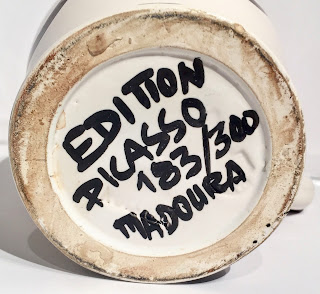Quatre Visages (Four Faces), 1959; White earthenware ceramic pitcher with colored engobe and glaze; Numbered 183/300, Inscribed 'EDITION PICASSO MADOURA', with the 'MADOURA PLEIN FEU' and the 'EDITION PICASSO' pottery stamps on the underside; Size - Quatre Visages (Four Faces): 9" x 7 1/2" x 7 1/2"; Catalogue Raisonne: A.R. 436.
"I am always doing that which I cannot do, in order that I may learn how to do it." - Pablo Picasso
During the late 1940s, Pablo Picasso spent the summers on the Cote d'Azur in the South of France. There the artist visited Vallauris for the annual pottery exhibition in 1946. He was impressed by the quality of the Madoura works and was introduced to the owners, Suzanne and Georges Ramié. The Ramiés welcomed the famous artist into their workshop and gave him access to all the tools and resources the he needed in order to work in the medium of ceramics. In exchange, the Ramié family would produce and sell his limited edition ceramic works and this relationship spanned 25 years. It was also at the Madoura factory in 1953 that Picasso met Jacqueline Roque, who would become his second wife in 1961.
During the late 1940s, Pablo Picasso spent the summers on the Cote d'Azur in the South of France. There the artist visited Vallauris for the annual pottery exhibition in 1946. He was impressed by the quality of the Madoura works and was introduced to the owners, Suzanne and Georges Ramié. The Ramiés welcomed the famous artist into their workshop and gave him access to all the tools and resources the he needed in order to work in the medium of ceramics. In exchange, the Ramié family would produce and sell his limited edition ceramic works and this relationship spanned 25 years. It was also at the Madoura factory in 1953 that Picasso met Jacqueline Roque, who would become his second wife in 1961.
Side view of Quatre Visages (Four Faces) Pitcher by Pablo Picasso
Side view of Quatre Visages (Four Faces) Pitcher by Pablo Picasso
Side view of Quatre Visages (Four Faces) Pitcher by Pablo Picasso
The Market for Picasso ceramics has been steadily rising as outlined by a recent article:
"Over the past 10 years, the market for Picasso ceramics has steadily grown, with seasoned collectors and new buyers alike vying for Picasso's editioned and unique ceramics at auction. This market is stable, with a steady high sell-through rate around 89% (87% in 2004, 89% in 2005, 87% in 2011, and 90% in 2012), and prices that are still lower than the rest of Picasso's work. The broad range of estimates and sales prices help make this market attractive to many collectors, but also explain the high average sales prices, which are skewed by a few exceptional pieces. In the previous two years, more than 60 exceptional ceramic works sold for over US$100,000: 34 in 2011 and 29 in 2012 (vs. six in 2004 and 2005)." - The Story Behind Picasso Ceramics, by Fanny Lakoubay and Conner Williams, 2013
"Over the past 10 years, the market for Picasso ceramics has steadily grown, with seasoned collectors and new buyers alike vying for Picasso's editioned and unique ceramics at auction. This market is stable, with a steady high sell-through rate around 89% (87% in 2004, 89% in 2005, 87% in 2011, and 90% in 2012), and prices that are still lower than the rest of Picasso's work. The broad range of estimates and sales prices help make this market attractive to many collectors, but also explain the high average sales prices, which are skewed by a few exceptional pieces. In the previous two years, more than 60 exceptional ceramic works sold for over US$100,000: 34 in 2011 and 29 in 2012 (vs. six in 2004 and 2005)." - The Story Behind Picasso Ceramics, by Fanny Lakoubay and Conner Williams, 2013
The famed artist Georges Bloch stated of Picasso’s ceramic works:
"…in approach, material and technique is as novel as it is interesting. Pottery, gleaming white discs with relief designs, monochrome or brightly coloured ovals, dishes and even jugs and vases here serve as bearers of compositions whose themes express the joyous, life-loving side of Picasso’s work. They are printed from blocks and stamps fashioned by the master over a period of more than twenty years in the Madoura pottery workshop in Vallauris.”
"…in approach, material and technique is as novel as it is interesting. Pottery, gleaming white discs with relief designs, monochrome or brightly coloured ovals, dishes and even jugs and vases here serve as bearers of compositions whose themes express the joyous, life-loving side of Picasso’s work. They are printed from blocks and stamps fashioned by the master over a period of more than twenty years in the Madoura pottery workshop in Vallauris.”
This is a wonderful four faces ceramic pitcher created in 1959, and the painting of the vessel is beautifully rendered with free form brown brushstrokes that are used to create the eyes, eyebrows, nose, and mouth of four faces. The four faces are joined by the left eye of one face making the right eye of the next, continuously around the vessel. This is a spectacular piece of original Pablo Picasso artwork and a great addition for any art collection!














































